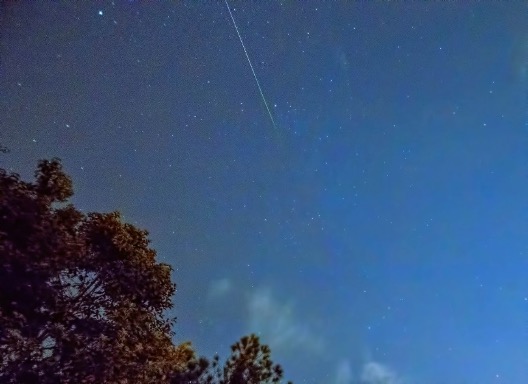Tips for viewing the 2024 Perseid meteor shower
By AMY SAYLE
CHAPEL HILL, NC (August 9, 2024)—Have you spotted any Perseid meteors yet? This year, the peak night of this famous annual meteor shower is predicted to be August 11/12 (Sunday evening into early Monday morning). The next night, August 12/13 (Monday evening into early Tuesday morning), may be just as good.
Sometimes misleadingly referred to as “shooting stars,” meteors are the streaks of light you see in the sky when cosmic debris slams into Earth’s atmosphere at thousands of miles per hour. The Perseids are the result of debris left over by Comet 109P/Swift-Tuttle on its periodic trips around the Sun.

Tips for viewing this year’s Perseids:
1. Check your weather forecast. Clear skies are ideal, but even just partly cloudy skies will do.
2. Choose a dark location. Find a safe spot away from city lights, with an open view of the sky. If watching from outside your home, turn off your house lights.
3. Choose a date and time. This choice depends on how much you value maximizing your meteor count vs. maximizing your sleep.
If you want to see the most meteors: Choose one of the peak nights, and go out during the last dark hours before dawn. That’s when your side of Earth is leading in space and sweeping up the most meteors. Also, because this year’s peak coincides with the first quarter moon, moonlight will obscure dimmer meteors until the Moon sets around midnight.
If you view in the last couple of hours before dawn, you get to witness something else cool: an apparent planetary pile-up! Reddish Mars and bright Jupiter are currently appearing to close in on each other in the eastern pre-dawn sky. On the peak Perseid mornings, they’ll be roughly a degree apart, the width of your pinky finger held at arm’s length. On August 14th, they’ll be just 0.3 degrees apart. Near this striking planetary pair will be the reddish star Aldebaran and the Pleiades star cluster.
If you don’t want to lose too much sleep: You can still expect to see Perseids during the more reasonable evening hours on one of the peak nights. You might even see a dramatic “earthgrazer”—a long, slow meteor.
If you miss the peak nights, try another night. The Perseid meteor shower started in the second half of July and is active well into August. Just don’t expect to see as many meteors after the peak.
4. Get comfy. Use a blanket, sleeping bag, or reclining chair so you don’t have to crane your neck and so you can get the widest possible view of the sky.
5. Look up! It’s surprisingly easy to miss meteors by looking at your friends or your phone. Your phone’s light will also hurt your night vision.
You don’t need fancy equipment to see meteors—just your eyes. The restricted view of a telescope or binoculars is counterproductive for meteor viewing.
6. Don’t worry about knowing how to identify Perseus. The Perseids get their name from the constellation they appear to fly away from, Perseus, which lies in the northeastern sky in August evenings. But the meteors can appear anywhere in the sky. Look at whatever part of your sky is the darkest.
7. Adjust your expectations. On the peak night of the Perseids, from a dark and moonless location, you might see more than one Perseid meteor per minute on average. Those watching from light polluted skies (which is most of us in North Carolina) or under bright moonlight will see only the brightest of the meteors.
Don’t let an inability to get to a dark viewing site completely discourage you, though. The Perseid meteor shower is famous for producing fireballs—very bright meteors.
8. Be patient. Plan on being outdoors for more than just a few minutes. Your eyes need time to adjust to the dark, and the meteors can come in clumps.
To learn about Morehead skywatching programs, see the skywatching page.
